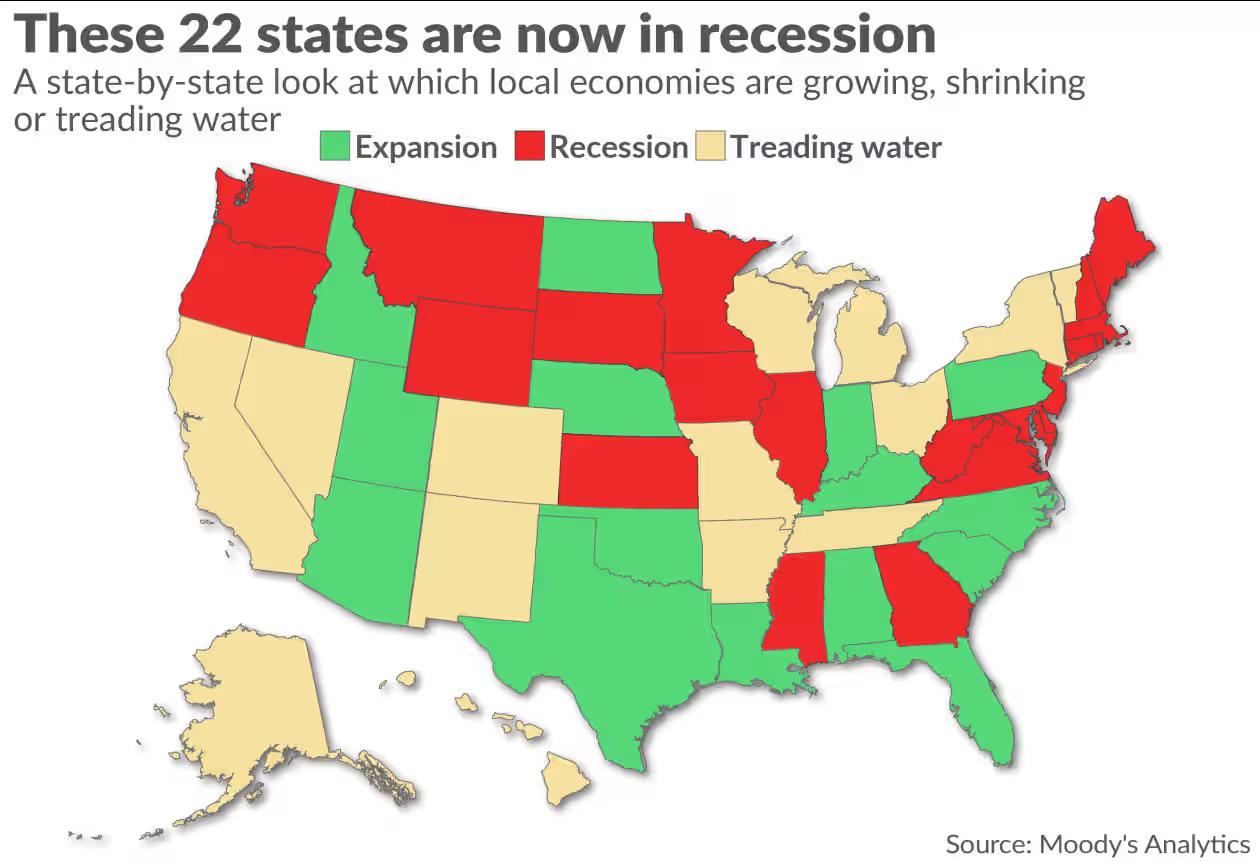Recession States Map of America as of October 2025


David Chen
Data Visualization Specialist
David Chen is an expert in transforming complex geographic datasets into compelling visual narratives. He combines his background in computer science ...
Geographic Analysis
What This Map Shows
This map provides a visual representation of the American states that are currently experiencing economic recession as of October 5th, 2025, according to Moody’s Analytics. The states marked in the visualization indicate regions where economic activity has significantly declined, affecting employment, consumer spending, and overall GDP growth. With a clear color coding, it’s easy to identify which areas are struggling economically and how widespread the issue might be.
Deep Dive into Economic Recessions
Recession is a period of temporary economic decline during which trade and industrial activity are reduced, generally identified by a fall in GDP in two successive quarters. Understanding the dynamics of recessions is crucial for grasping broader economic trends. Economists often look at various indicators, such as unemployment rates, consumer confidence, and industrial production, to assess the health of an economy.
Interestingly, recessions can be triggered by numerous factors, including high inflation, rising interest rates, or external shocks like natural disasters or geopolitical tensions. For example, the recession in 2025 has been attributed to a combination of high inflation rates that have persisted since 2023 and supply chain disruptions that have yet to fully recover from previous global crises.
One of the most significant aspects of a recession is its impact on employment. Typically, businesses cut back on hiring or lay off workers to manage costs, leading to higher unemployment rates. In states currently marked in our visualization, we see a range of unemployment figures, with some states experiencing rates upwards of 10%. This can create a feedback loop, where reduced consumer spending further exacerbates the economic downturn.
Moreover, the geographic distribution of recessions can reveal valuable insights. States heavily reliant on specific industries, such as energy or agriculture, may suffer more acutely during downturns. For instance, states like Wyoming and Alaska, which depend on fossil fuels, are feeling the pinch as energy prices fluctuate. Conversely, states with diversified economies may weather economic storms more effectively.
Regional Analysis
When examining the regions displayed on the map, it's striking to note the variations in recession impact. The Midwest, for example, has several states in recession, including Michigan and Ohio, where manufacturing has faced significant challenges. The decline in production has not only affected the industrial sector but has also trickled down to service jobs, which are essential for local economies.
On the other hand, the Southeast appears to be faring slightly better, with states like Florida and Georgia remaining resilient due to their booming tourism and technology sectors, respectively. However, even these states are not entirely immune; as inflation continues to rise, consumer spending in these areas is starting to wane.
Interestingly, some states that are not in recession are experiencing growth, albeit at a slower pace. For instance, Texas and Utah have shown remarkable adaptability, with strong job growth in tech and renewable energy sectors, allowing them to remain insulated from the broader economic malaise.
Significance and Impact
The significance of understanding which states are in recession cannot be overstated. Economic downturns can have far-reaching implications, affecting everything from public services and infrastructure development to social welfare programs. As states grapple with budget deficits due to decreased tax revenue, important services may face cuts, impacting the most vulnerable populations.
Furthermore, the current recession trends may have long-term effects on the economy. For example, prolonged high unemployment can lead to skill degradation among workers, making it challenging for them to reintegrate into the workforce once the economy recovers. This phenomenon raises questions about the future workforce and economic resilience.
As we look ahead, projections indicate that while some states may recover in the next few years, others could continue to struggle without significant policy interventions. Economists emphasize the need for targeted fiscal policies to stimulate growth in the affected states. Recovery strategies might include job training programs, investment in infrastructure, and incentives for businesses to relocate or expand in recession-hit areas. The path forward will require collaboration between state governments, businesses, and communities to foster economic resilience and adaptability in the face of future challenges.
In conclusion, this map not only highlights the current economic landscape of the United States as of October 2025 but also serves as a critical tool for understanding the broader implications of recession on local and national levels. Keeping a close eye on these trends will be essential for policymakers and citizens alike as they navigate through these turbulent economic waters.
Visualization Details
- Published
- October 7, 2025
- Views
- 82
Comments
Loading comments...